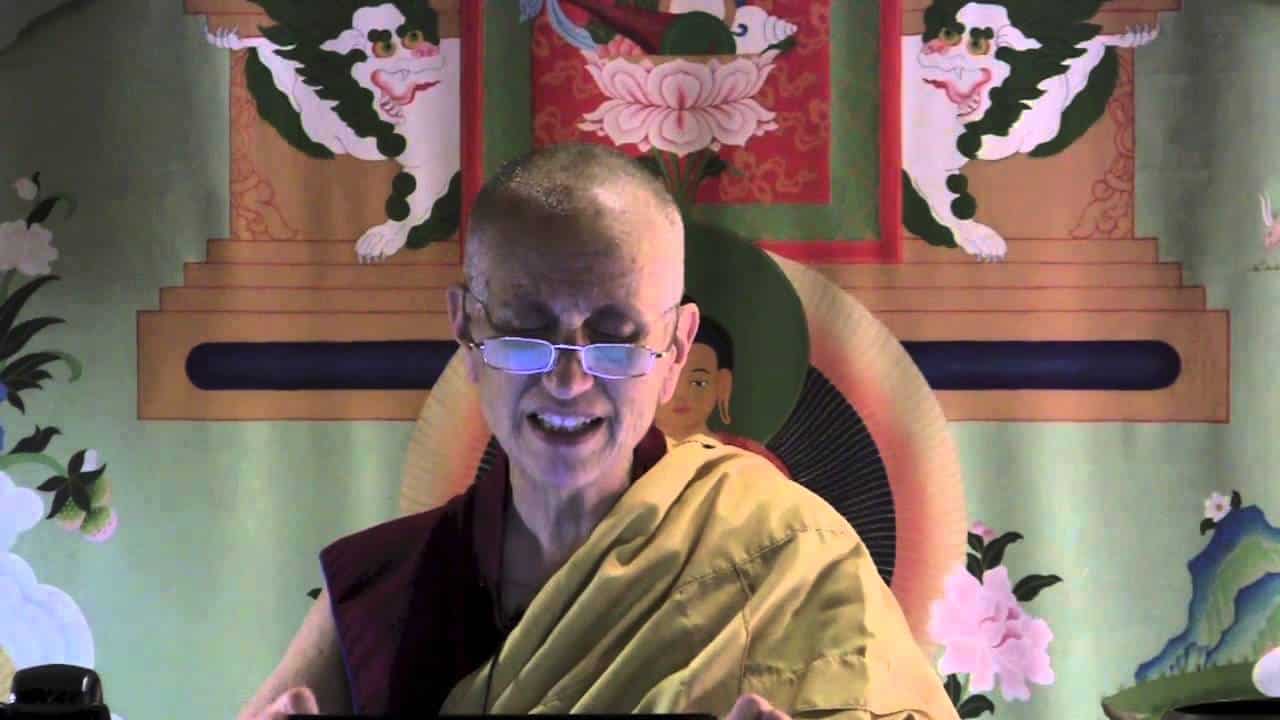How to practice between sessions
Part of a series of teachings and short talks given during the Manjushri and Yamantaka Winter Retreat in 2015.
- Tonglen meditation to deal with difficult situations
- How to see sentient beings as Manjushri
- What it means to see the environment as Manjushri’s mandala
- Loosening our hold on the solidness of our thoughts and emotions
How to practice between sessions (download)
One more thing I wanted to add on to the response to the person who asked about racism earlier in the week, and what to do on a personal level when confronting it …. I was thinking that the taking-and-giving meditation is really excellent to do in that kind of situation. Because I know whenever I confront difficult situations like that where there’s no easy solution, really seeing the pain of others and wishing them well and taking it on myself. Using it to destroy (in this case) my own bias, my own prejudice, my own intolerance of other people. And then imagining giving my body, possessions and virtue to others, in this case, really giving others an open mind and the opportunity to learn from others whereby they can expand their horizons and open their minds. So doing this kind of taking-and-giving meditation I think could be very very effective to keep one’s own heart open and avoid anger when confronting racism or any other kind of discrimination.
Then, today’s question. Somebody wrote and they’re asking about how to practice during the break times as advised in the Manjushri sadhana where it’s said to see all sights as Manjushri and Manjushri’s mandala, to see all sounds as his mantra, and to see all your thoughts as Manjushri’s unlimited compassion and wisdom. So what in the world does that mean?
This is a skillful way to practice in order to avoid ignorance, anger, and attachment. That’s the purpose of this.
The first one: to see sentient beings as Manjushri and the environment as Manjushri’s mandala. It doesn’t mean that we go around visualizing everybody’s Manjushri holding a sword. You know, “Could you please put your sword down and pass me the ketchup?” [laughter] And it doesn’t mean that we kind of try and change what our eyes are seeing and “oh, everything’s all glittering and everything’s beautiful and radiating buddhas” and things like that. This is not something done with our visual consciousness. This is something done with our mental consciousness.
What it means is when you see other sentient beings, instead of having the judgmental, critical mind that looks at them and says, [sigh] “They came in two seconds late for the meditation session. Again …. They slammed the door [sigh] …. They’re dragging their feet …. They gave me a dirty look …. We had a discussion group and they said something outrageous ….” Or just even remembering things in the past. “This person beat me up …. This person humiliated me in front of an audience of people ….” You know? All this stuff is coming up. So instead of looking at other people as ordinary with our judgmental, critical mind which then is going to make us very unhappy and create a lot of negative karma, we step back from that and we say, “This person has the buddha nature. They have the potential to become Manjushri.” So we focus on their potential to become Manjushri, the fact that they have the clear light nature of mind, they have the buddha nature. And when we focus on that then we’re not seeing all those petty things that we usually criticize. We’re not getting involved in the litany of harmful things they’ve done to us in the last four countless great eons. But instead we’re seeing this is a sentient being who has the buddha nature, who has some goodness inside, who can improve. Okay? So we’re seeing them as like the Manjushri that they can become because they have the seed of that in their mind right now. When we look at them that way then we don’t fall prey to the judgmental, critical mind.
Similarly when we look at the environment. Instead of “Oh, this is dirty …. And the weather’s the same old thing,” and blah blah blah, which again focuses on what we don’t like, then we try and see it in a pure way so that we see our environment as satisfactory. The place where I live in is satisfactory. This is okay. It’s like a mandala. It’s empty of inherent existence. I don’t have to grasp onto the inherent existence of anything.
Then the second part was seeing all the sounds as Manjushri’s mantra. It doesn’t mean that everything that you’re hearing is “om ah ra pa tsa na dhih.” And it’s like, you know, whatever somebody says to you is “om ah ra pa tsa na dhih.” I mean, if it were then you wouldn’t have to say “What? Pardon me?” Because you’d already know what they were saying. Okay? [laughter] It again means, like, regarding it as sound. Regarding what we hear as sound that is empty of inherent existence. Because right now we hear sounds as “oh, this is inherently an awful sound, I don’t want to hear it.” Or, “What this person says is wrong, it’s bad. They’re criticizing me. They’re not respecting my ideas. They’re not listening to me.” As if the pain and the disrespect and the offense were there in the words that were coming towards us. So to see, no, that all of our emotional reactions are not in the other person’s words. What’s coming towards us is basically sound waves. All of our emotional reactions are starting from here going out. They’re not coming from the sound waves. So, when you’re getting offended or upset by what you hear to say “this is empty of inherent existence.” I mean, that’s the meaning of “om ah ra pa tsa na dhih” is generating that wisdom so I don’t have to have strong emotions in response to these different sounds that I’m hearing. I can see them as empty. I can see them as just purely sounds. And not put all my afflicted interpretation on top of them.
Then the third one: seeing all your thoughts as Manjushri’s unlimited compassion and wisdom. That doesn’t mean I’m sitting there and saying “I hate this guy’s guts,” and “Oh, I don’t have to change that attitude because that’s compassion and wisdom.” [laughter] If you don’t understand these things correctly (and I’ve heard people who do not understand them correctly) you can really get very confused. Here it doesn’t mean that all your ordinary thoughts are wisdom and compassion therefore you don’t need to do anything about your bigotry and your hatred and your jealousy and your craving. It doesn’t mean that. It just means, again, stepping back and seeing that all these emotions or views or attitudes are again empty of true existence.
I think this is a very important point. Because sometimes when a disturbing emotion arises in our mind we really latch onto it. It’s like, “I am so depressed today …. I am so angry today …. I am overwhelmed with jealousy ….” You know? And it’s like, we cannot get ourselves out of it because the emotion seems so real. But if you stop and say to yourself, “Okay, what is jealousy? Can you find jealousy? What is it that I’m saying is jealousy?” Or you can ask it in another way: “How do I know I’m jealous?” Okay? And, you know, you examine this and what you discover is that there’s no truly existent thing that is jealousy (or anger, whatever it is) out there that’s just waiting to manifest in your mind. You know? Jealousy is simply different mind moments that happen sporadically throughout your life that have the similar quality of not being able to endure somebody else’s happiness. And on the basis of that similar quality all these different moments of mind are given a term to show their similarity and that term is jealousy.
I think looking at our afflictions in this way is much different than the way that people often look at them in a psychological way because you hear people say, “I have repressed anger.” You hear that all the time. And I don’t know about you but I get the idea that repressed anger …. Here’s this thing that’s like ugly and ferocious and stinky that’s just sitting there inside of—if I have repressed anger—that’s just sitting inside of me, this ugly filthy stinky thing, sitting inside of me, even when I’m happy, even when I’m smiling. Because it’s repressed anger and so no matter what’s going on it’s there, and that at any time it’s going to come up and destroy the world. Because it’s truly existent and there’s nothing that can be done about it.
And that’s not what anger is. That’s not what jealousy is. It’s simply—you know, jealousy, anger, depression, even, whatever it is—it’s just different mind moments. And they aren’t even happening all the time. They could be happening today, then you don’t have them for another two days, or you don’t have them for another week, or whatever. So it’s just different mental events that have some kind of common characteristic that we give the label “jealousy.” We give the label “anger.” We give the label “craving.”
When you see these afflictions in that way they become so much looser, don’t they? This idea of “repressed anger” that’s always there. There isn’t any repressed anger that’s always there because anger isn’t always manifest in our mind, is it? The seed of anger may be there, but the seed of anger is not repressed anger, which means that you’re actually angry under the surface even when you’re happy.
Do you get what I mean? Really think about your afflictions in this way. It becomes so much easier to deal with them because they don’t appear so solid then. Because they aren’t so solid. So, when you see your afflictions aren’t so solid, that they’re empty of true existence, then you can see them with wisdom, you can see them with compassion, you can generate wisdom and compassion for others. Because these mental events are just some kind of mental energy, and you can redirect that energy and leave the afflicted part behind.
So, that’s what those three mean. Try them. They really work very well to pull us out of our ordinary view. And they help us to see that our ordinary view is basically just habitual garbage. It’s just a habit that really isn’t true. So again that gives us much more confidence in our ability to drop some of these things.
Venerable Thubten Chodron
Venerable Chodron emphasizes the practical application of Buddha’s teachings in our daily lives and is especially skilled at explaining them in ways easily understood and practiced by Westerners. She is well known for her warm, humorous, and lucid teachings. She was ordained as a Buddhist nun in 1977 by Kyabje Ling Rinpoche in Dharamsala, India, and in 1986 she received bhikshuni (full) ordination in Taiwan. Read her full bio.


